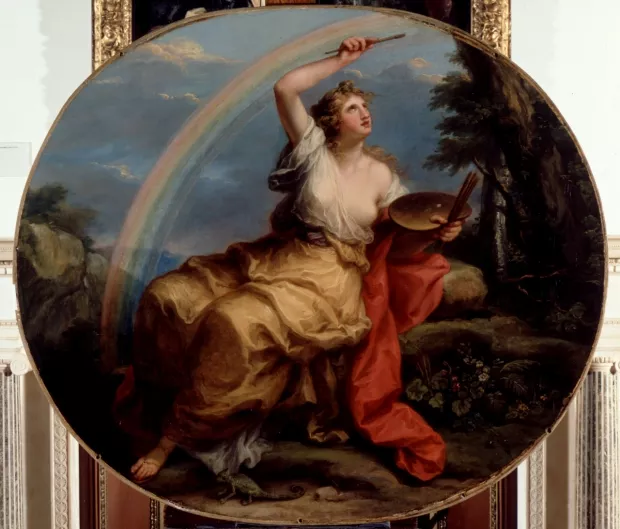Creation Date
1780
Height
113 cm
Width
150 cm
Medium
Genre
Description
Angelica Kauffman was commissioned to paint four allegorical figures representing the four components of painting: design, composition, invention, and color. They first decorated the Royal Academy’s location in Somerset House on the Strand, and were later moved to Burlington House; Colour, as well as the other three paintings, remains displayed on the ceiling of Burlington House (Eger 118).
Kauffmann’s family came to Italy in 1752, where she began working as a portrait painter at age eleven (Gerard 6). She spent several years in Milan, interacting with the nobility whose portraits she painted, and learning a great deal about Italian culture and art (Gerard 10). She came to live in England in 1766 under the protection of Lady Wentworth, the wife of the English Resident at Venice (Gerard 35, 39). Soon afterwards she became one of the founding members of the Royal Academy of Arts (established in 1768), and her close friendship with Sir Joshua Reynolds, the founder of the Academy, helped her gain popularity and credibility as an artist (Gerard 114).
In 1768, Helferich Peter Sterz visited Kauffman’s studio. Despite his opinion that “as a painter she lacks important parts of the art . . . she has to avoid action-laden inventions,” he went on to state that her forms “are full of grace, posed entirely in the Greek quiet dignity; and in her female figures is a singular, inimitable femininity” (Rosenthal 190).
A woman with loose hair in a flowing costume sits on a grassy ledge. In one hand she carries an empty palate and several paintbrushes; with the other she uses a brush to take pigment from the rainbow arcing over her head. A chameleon sits at her feet. She is framed by rocks, trees, and flowers, and there are a few clouds in the bright sky behind her.
Kauffman was one of only two female members of the Royal Academy from its founding until 1922. She was immensely popular and successful, painting Neoclassical subjects as well as portraiture and even historical events, a genre usually closed to women. Resourceful in the face of social restrictions, Kauffman used statues in place of the living models she was forbidden to observe (Gerard 75).
In addition to emblematizing an element of art in general, Colour manifests itself in the image's own rich and imaginative use of color. Her subject steals the tints of the rainbow to add to her palette, and her freely flowing clothes further contribute to an image liberated from the plausible or mundane. Allegories in Romantic art often consist of fantastic images, and in order to accurately represent and embody "color" Kauffman substitutes metaphor for reality: the figure of Colour would not be "Colour" if she lacked the implausible but conceptually necessary ability to mix the intangible colors in the sky.
Associated Works
Locations Description
The Royal Academy of Arts
Kauffman was one of the first two female members of the Royal Academy (Gerard 114).
Italy
Kauffmann's lengthy residency in Italy, beginning in childhood, gave her work a classical influence (Gerard 10).
Copyright
Copyright, 2009, Romantic Circles.
Collection
Accession Number
03/1130
Additional Information
Bibliography
Eger, Elizabeth, and Charlotte Grant. Women, Writing, and the Public Sphere 1700-1830. Cambridge: Cambridge UP, 2001. Print.
Gerard, Francis A. Angelica Kauffmann: A Biography. London, 1893. Print.
Goodden, Angelica. Miss Angel: the Art and World of Angelica Kauffman. London: Pimlico, 2005. Print.
Rosenthal, Angela. Angelica Kauffman: Art and Sensibility. New Haven: Yale UP, 2006. Print.

